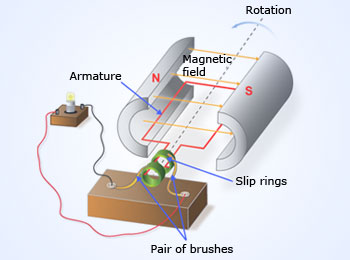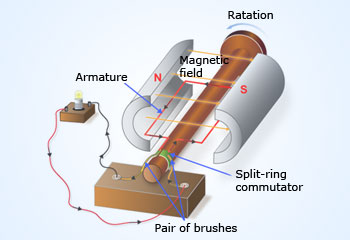 AC generators
The energy conversion is based on the Faraday's law of EM induction.
AC generators
The energy conversion is based on the Faraday's law of EM induction.
Generators:
There are two types of generators: (a) AC generators and (b) DC generators.
(a) AC generator:
If we rotate a coil of wire in a magnetic filed, it produces an alternating current. The magnetic flux between the poles of the magnet are cut by the rotating coil, inducing a lot of current. A commutator (pair of slip rings) is used in order to get the current out of the coil which helps in preventing the entanglement of the wires when they connect directly to the coil.
 DC generators
DC generators
(b) DC generator:
If we replace the slip rings with two brushes, then the current that is produced will be Direct current, since only one side of the ring will be in contact with the brush.
In any generator, the whole assembly carrying the coils is called the armature, or rotor. The stationary part constitute the stator. In general, AC and DC generators use electromagnets, instead of permanent magnets. The field current for the electromagnets is most often DC from an external source. The term dynamo is often used for the DC generator; In modern days the generator that is used in almost all types of automobiles is usually a dynamo.
The right hand rule is applicable for generators:
- The first finger of the right hand points in the direction of the magnetic field (FIRST FINGER represents the magnetic FIELD), which goes from the North pole to the South pole.
- The thumb of the right hand points in the direction of the motion of the wire in the magnetic field (THUMB represents the TORQUE or THRUST).
- The second finger of the right hand points in the direction of the induced current in the wire (SECOND FINGER represents the current). Heat produced by the coils. This loss of energy as heat can be reduced by using oil.